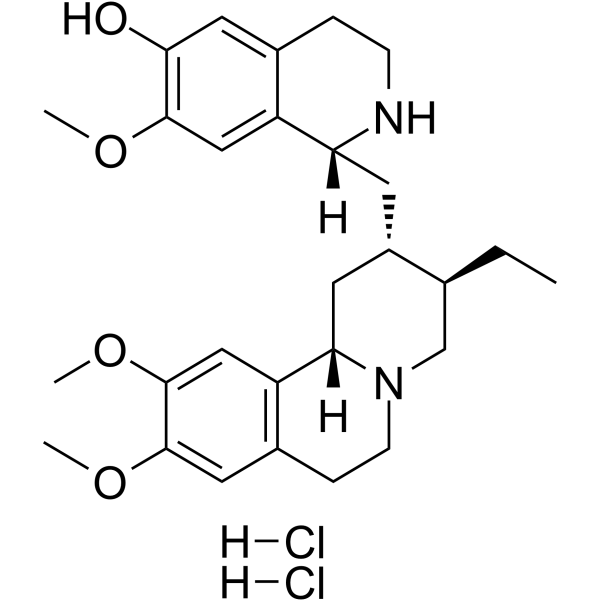
Cephaeline Dihydrochloride
CAS No. 5853-29-2
Cephaeline Dihydrochloride( —— )
Catalog No. M31773 CAS No. 5853-29-2
(-)-Cephaeline (dihydrochloride) is an enantiomer of Cephaeline. Cephaeline is a selective CYP2D6 inhibitor (IC50: 121 μM).
Purity : >98% (HPLC)
 COA
COA
 Datasheet
Datasheet
 HNMR
HNMR
 HPLC
HPLC
 MSDS
MSDS
 Handing Instructions
Handing Instructions
| Size | Price / USD | Stock | Quantity |
| 50MG | Get Quote | In Stock |


|
| 100MG | Get Quote | In Stock |


|
Biological Information
-
Product NameCephaeline Dihydrochloride
-
NoteResearch use only, not for human use.
-
Brief Description(-)-Cephaeline (dihydrochloride) is an enantiomer of Cephaeline. Cephaeline is a selective CYP2D6 inhibitor (IC50: 121 μM).
-
Description(-)-Cephaeline (dihydrochloride) is an enantiomer of Cephaeline. Cephaeline is a selective CYP2D6 inhibitor (IC50: 121 μM).
-
In VitroCYP2D6 reveals the highest metabolic activity for the generation of 9-O-demethylEmetine, whereas this enzyme also shows a significant metabolic activity for the generation of Cephaeline. The IC50s of Cephaeline against CYP2C9, CYP2D6 and CYP3A4 is over 1000, 121 and 1000 μM, respectively. Further experiments are performed to determine inhibition constants (Ki) for Cephaeline on the CYP2D6 and CYP3A4 activities Graphic analysis of Dixon plots at various Cephaeline concentrations for each of the two CYP enzyme assays yield Kis of 54 and 355 μM for CYP2D6 and CYP3A4, respectively.
-
In Vivo——
-
Synonyms——
-
PathwayOthers
-
TargetOther Targets
-
Recptor——
-
Research Area——
-
Indication——
Chemical Information
-
CAS Number5853-29-2
-
Formula Weight539.53
-
Molecular FormulaC28H40Cl2N2O4
-
Purity>98% (HPLC)
-
SolubilityIn Vitro:?DMSO : 250 mg/mL (463.37 mM)
-
SMILES——
-
Chemical Name——
Shipping & Storage Information
-
Storage(-20℃)
-
ShippingWith Ice Pack
-
Stability≥ 2 years
Reference
molnova catalog



related products
-
Dihydroresveratrol
Dihydroresveratrol is a major metabolite of resveratrol that is produced by animal-associated bacteria, including the gut microbiota.?Dihydroresveratrol and dihydroresveratrol monosulfate are detectable in urine.?
-
ELA-14 (human)
Potent apelin (APJ) receptor agonist (Ki = 0.93 nM). Bioactive fragment of ELA-32. Activates Gαi1 pathway and β-arrestin-2 recruitment. Reduces arterial pressure in rat hearts. Active in vivo.
-
Ganoderlactone D
Ganoderlactone D is a natural product.



 Cart
Cart
 sales@molnova.com
sales@molnova.com


